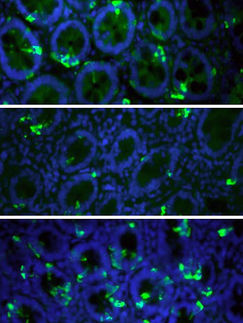New approach for the development of a drug treatment for obesity and the resulting diseas
The protein Asc-1 regulates whether fat-burning beige or fat-storing white adipocytes are formed, which can have an impact on the development of metabolic diseases. This is shown by a current study of the Helmholtz Zentrum München and the German Center for diabetes Research (DZD). The results open up new approaches to prevent the development of metabolic diseases. The study has now been published in Nature Communications.
Not all fat is the same: there is white, brown and beige adipose tissue. While white fat cells serve as energy stores, excess energy is burned in brown and beige fat tissue. Too much white fat is considered unhealthy. If the white adipose tissue increases significantly in adults with obesity, metabolic diseases such as diabetes or metabolic syndrome can develop. The situation is different in children: There, the initial formation of white adipose tissue is a prerequisite for a healthy metabolism. But how does adolescent adipose tissue differs from adult white adipose tissue? To answer this question, researchers have investigated the composition of white adipose tissue of young and adult mice using single cell RNA sequencing.
Asc-1 promotes the formation of white adipocytes
The researchers found that adolescent adipose tissue differs greatly from adult white fat, especially in terms of the properties and composition of fat precursor cells. The researchers discovered a special subgroup of fat precursor cells in adolescent adipose tissue that contain the protein Asc-1, which is otherwise present in mature adipocytes. These precursor cells differentiate predominantly into white adipocytes, and the formation of "healthy" beige adipocytes is actively suppressed. In further cell biological investigations, the team around first author Lisa Suwandhi were able to show that the loss of Asc-1 function promotes the formation of beige adipocytes.
"These insights into the physiological processes of adipose tissue growth enable us to develop new strategies to prevent the harmful metabolic consequences of obesity," said last author Dr. Siegfried Ussar. The researchers are already pursuing this approach further. They are currently establishing strategies to modulate Asc-1 function in adipose tissue in the living organism and exploring ways to promote healthy adipose tissue expansion. The goal is to help obese patients maintain a healthy metabolism in the future and thus gain time to treat obesity with a holistic approach.
Original publication
Other news from the department science

Get the life science industry in your inbox
By submitting this form you agree that LUMITOS AG will send you the newsletter(s) selected above by email. Your data will not be passed on to third parties. Your data will be stored and processed in accordance with our data protection regulations. LUMITOS may contact you by email for the purpose of advertising or market and opinion surveys. You can revoke your consent at any time without giving reasons to LUMITOS AG, Ernst-Augustin-Str. 2, 12489 Berlin, Germany or by e-mail at revoke@lumitos.com with effect for the future. In addition, each email contains a link to unsubscribe from the corresponding newsletter.




















































